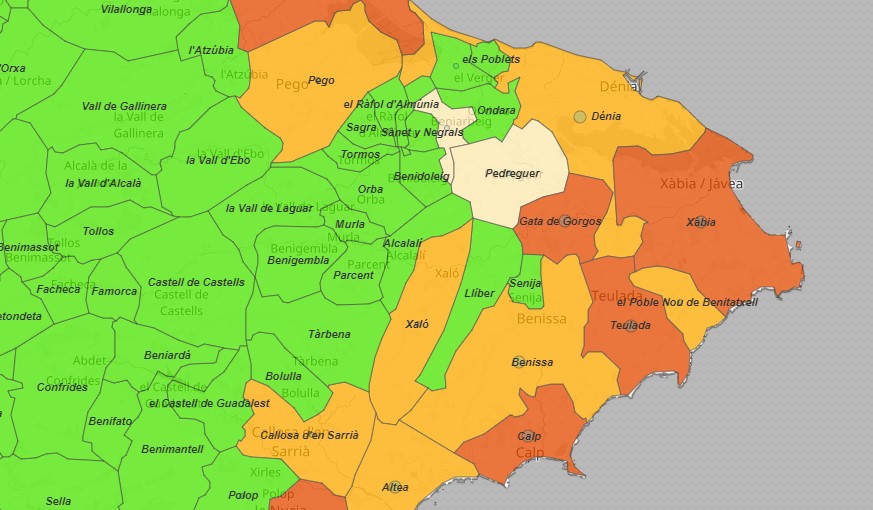VIRUS UPDATE: Young people fuelling rise in infection spread across Valencia
Regional health secretary Ana Barceló called on the public to maintain prudence. “we have said it many times; the pandemic is not over yet.”

Tuesday 6th July 2021 – Compiled by MIKE SMITH
The total number of positive coronavirus cases detected by PCR test in Xàbia has climbed to 1,555, according to the latest update from the regional health ministry. The number of cases detected in the past 14 days stands at 47 cases, which means that the municipality’s 14-day IA rate, a measure of the speed at which the virus moves through the population, has soared to to 167.76 cases per 100,000 inhabitants, the highest it has been since mid-February, and the town has risen into the ‘High Risk’ alert level. There have been no new deaths in Xàbia since late March and the number remains at 12.
In the Marina Alta region, there have been 186 new positive cases detected in the past 14 days whilst the total number of positive cases since the pandemic began has been confirmed as 10,374 since the last update, a rise of 67:
- 20 – Xàbia
- 13 – Calp
- 13 – Dénia
- 7 – Teulada
- 6 – Benissa
- 4 – Pego
- 2 – Xaló
- 1 – Gata de Gorgos
- 1 – Poble Nou de Benitatxell
The region’s 14-day IA rate has risen to 108.42 cases per 100,000 inhabitants – a whopping 585% higher than it was two weeks ago – and the region is in the ‘Medium Risk’ category. There have been no new deaths since the last update and the region’s toll remains 203.
Gata de Gorgos leads the way with a rate of 208.23 new cases per 100,000 inhabitants and it is joined by Xàbia (167.76), Calp (167.20) and Teulada (159.60) at the ‘High Risk’ level. Benissa (141.74), Xaló (104.60), Poble Nou de Benitatxell (89.95), Dénia (81.72) and Pego (59.21) are at the ‘Medium Risk’ level, whilst Beniarbeig (46.32) and Pedreguer (38.07) are in the ‘Low Risk’ category.
The rest of the municipalities in the region are at the ‘New Normal’ level, with 21 of them, the majority inland rural communities, showing no infection spread over the last 14 days.
Spain
Spain’s 14-day IA rate is 204.16 cases per 100,000 inhabitants and the country has risen back in the ‘High Risk’ category for the first time since mid-May. The rate has been rising for almost two weeks and is now 121% higher than it was a fortnight ago. The numbers are clearly showing that the infection spread is being accelerated by the younger population who have not yet been vaccinated; the 20-29 age group has a 14-day IA rate of 640.13, more than three times higher than the national average, and only 10.5% of that age group have been fully immunized.
Consequently, the Positivity Rate, the measure of how many coronavirus tests return positive, has risen to 8.38%, almost double the value it was two weeks ago. A value of 5% or less indicates that transmission of the virus is more or less under control.
Cases might be soaring but the pressure on the hospital system is coping with 2.26% of beds in general wards occupied by patients being treated for COVID-19, slightly up on two weeks ago, whilst 6.73% of ICU beds are occupied by such patients, a decrease of 6.5% on two weeks ago.
Across Spain, all but one of the 19 autonomous communities and cities has seen positives cases rise over the past two weeks with the Comunidad Valenciana and Cataluña particularly suffering a surge in infection spread (379% and 376% higher, respectively, than two weeks ago) and the Baleares (352% rise) not too far behind. Cataluña leads the way with an IA rate of 439.81 cases per 100,000 population.
In terms of 14-day IA rate, Cataluña and Cantabria are currently at Very High Risk alert level, 10 autonomous regions are at High Risk level, including the Comunidad Valenciana, 6 are at Low Risk, and Ceuta is at the Low Risk level. No regions finds itself in the New Normal at the beginning of this week.
The Comunidad Valenciana has seen infection spread soar by more 379% over the past two weeks, a rise fueled mainly in the younger population, and the regional health secretary Ana Barceló has stressed that “these figures show what we have said many times, that the pandemic is not over yet. We have managed to weaken the most serious effects of the virus, especially in the most vulnerable population, but we still have to go one step further with the maximum shared responsibility to end it“.
The newspaper El País has reported the figures from the European Centre for Disease Control and Prevention (ECDC) show that Spain has the third-highest infection spread rate behind Portugal and Cyprus, but it has the lowest 14-day mortality rate per 100,000 population of all the large states in the European Union at 5.75, below France (8.57), Italy (7.88) and Germany (11.04), the latter of which has a 14-day IA rate ten times lower than Spain. Pedro Gullón, from the Spanish Epidemiology Society, said that there are several explanations for these differences: Spain may have a greater capacity to detect new cases than other countries; many vulnerable people in the country have died from COVID-19, meaning the mortality rate is unlikely to spike; the vaccination strategy in Spain by age groups has been one of the most effective in Europe; and lastly the incidence rate has only recently started to rise and, as such, has not yet been reflected in the number of deaths
Vaccination (05.07.21)
Spain has administered 43,959,621 doses of vaccine, which is 93.4% of those which it has already received. A total of 19,135,448 people have completed the recommended course, which is 45.4% of the total of the population which is to be vaccinated (40,129,822).
According to the latest data provided by the health authorities, 88.1% of people aged 40 and over in Spain have received at least one dose, with 56.1% having completed the recommended course.
The Comunidad Valenciana has administered 4,379,539 doses of vaccine, which is 90.2% of the total which it has received. A total of 1,901,688 people have completed the recommended course, which 42.4% of the population which is to be vaccinated (4,289,305).
According to the latest data provided by the health authorities, 85.9% of people aged 40 and over in the Comunidad Valenciana have received at least one dose, with 54.6% having completed the recommended course.
LINKS
- Actualización nº 411. Enfermedad por el coronavirus (COVID-19). 05.07.2021
- GIV COVID-19 Gestión integral de la vacunación COVID-19
- COVID-19 C. Valenciana: Monitoratge de la situació



